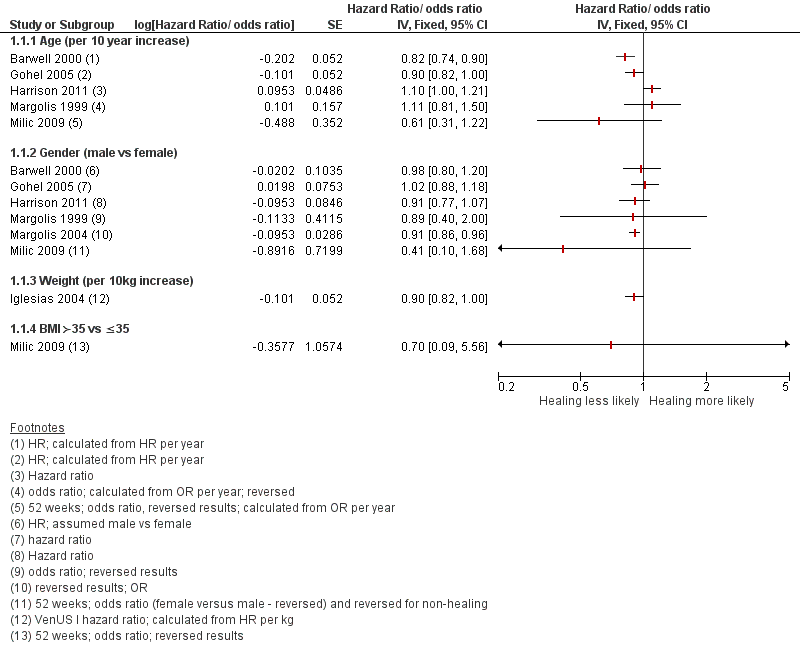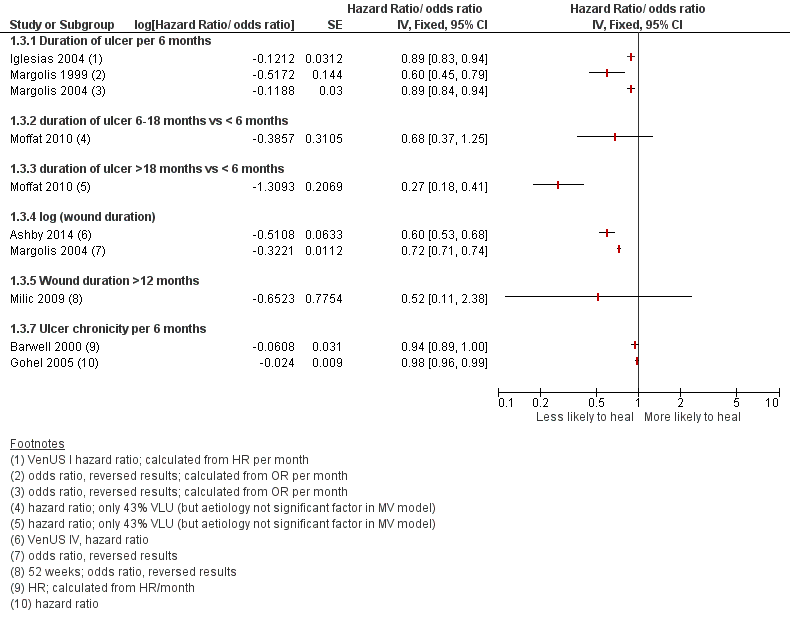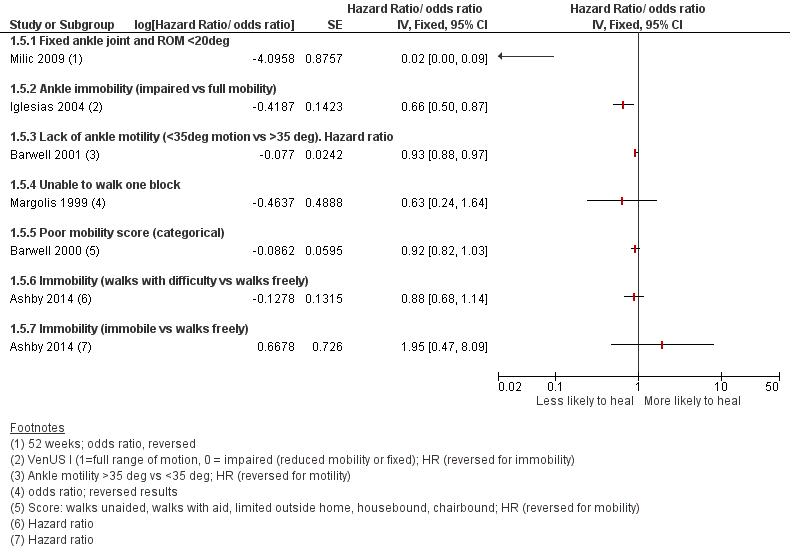Protease activity as a prognostic factor for wound healing in venous leg ulcers
Información
- DOI:
- https://doi.org/10.1002/14651858.CD012841Copiar DOI
- Base de datos:
-
- Cochrane Database of Systematic Reviews
- Versión publicada:
-
- 30 octubre 2017see what's new
- Tipo:
-
- Prognosis
- Etapa:
-
- Protocol
- Grupo Editorial Cochrane:
-
Grupo Cochrane de Heridas
- Copyright:
-
- Copyright © 2017 The Cochrane Collaboration. Published by John Wiley & Sons, Ltd.
Cifras del artículo
Altmetric:
Citado por:
Autores
Contributions of authors
Maggie Westby: developed the protocol; coordinated the protocol development; produced the first draft of the protocol; contributed to writing or editing the protocol; made an intellectual contribution to the protocol; approved the final version of the protocol prior to submission; and is guarantor of the protocol.
Jo Dumville: conceived the review question; developed the protocol; coordinated the protocol development; secured funding; contributed to writing or editing the protocol; made an intellectual contribution to the protocol; and approved the final version of the protocol prior to submission.
Nikki Stubbs: contributed to writing or editing the protocol; made an intellectual contribution to the protocol; advised on the protocol; and approved the final version of the protocol prior to submission.
Gill Norman: contributed to writing or editing the protocol; made an intellectual contribution to the protocol; and approved the final version of the protocol prior to submission.
Jason Wong: contributed to writing or editing the protocol; made an intellectual contribution to the protocol; advised on the protocol; and approved the final version of the protocol prior to submission.
Nicky Cullum: conceived the review question; developed the protocol; coordinated the protocol development; secured funding; contributed to writing or editing the protocol; made an intellectual contribution to the protocol; and approved the final version of the protocol prior to submission.
Richard Riley: contributed to writing or editing the protocol; advised on the protocol; made an intellectual contribution to the protocol; and approved the final version of the protocol prior to submission.
Contributions of the editorial base
Tanya Walsh (Editor): edited the protocol; advised on methodology, interpretation and protocol content; approved the final protocol prior to submission.
Gill Rizzello (Managing Editor): coordinated the editorial process; advised on content; edited the protocol.
Ursula Gonthier (Editorial Assistant): edited the reference section.
Sources of support
Internal sources
-
Division of Nursing, Midwifery and Social Work, School of Health Sciences, Faculty of Biology, Medicine and Health, University of Manchester, UK.
External sources
-
National Institute for Health Research (NIHR), UK.
This project was supported by the NIHR, via Cochrane Infrastructure and Cochrane Programme Grant funding (NIHR Cochrane Programme Grant 13/89/08 – High Priority Cochrane Reviews in Wound Prevention and Treatment) to Cochrane Wounds. The views and opinions expressed herein are those of the authors and do not necessarily reflect those of the Systematic Reviews Programme, the NIHR, the NHS or the Department of Health.
-
NIHR Manchester Biomedical Research Centre (BRC), UK.
This project was supported by Manchester BRC.
-
National Institute for Health Research Collaboration for Leadership in Applied Health Research and Care (NIHR CLAHRC), Greater Manchester, UK.
Nicky Cullum and Jo Dumville's work on this project was partly funded by the NIHR CLAHRC, Greater Manchester. The funder had no role in the decision to publish, or preparation of the manuscript. However, the protocol may be considered to be affiliated to the work of the NIHR CLAHRC Greater Manchester. The views expressed herein are those of the authors and not necessarily those of the NHS, NIHR or the Department of Health.
Declarations of interest
Maggie Westby: my employment at the University of Manchester is funded by the NIHR and focuses on high priority Cochrane Reviews in the prevention and treatment of wounds.
Jo Dumville: I receive research funding from the NIHR for the production of systematic reviews focusing on high priority Cochrane Reviews in the prevention and treatment of wounds. This work was also partly funded by the National Institute for Health Research Collaboration for Leadership in Applied Health Research and Care (NIHR CLAHRC) Greater Manchester.
Nikki Stubbs: funding from pharmaceutical companies supports training and education events in the service and payments have been received by the author for non‐product‐related educational sessions. These have been unrelated to the subject matter of the systematic review and have never been in support or in pursuit of the promotion of products.
Gill Norman: my employment at the University of Manchester is funded by the NIHR and focuses on high priority Cochrane Reviews in the prevention and treatment of wounds.
Jason Wong: none known.
Nicky Cullum: receives research funding for wounds‐related research and systematic reviews from the NIHR.
Richard Riley: none known.
Acknowledgements
We are grateful to peer reviewers Anne‐Marie Glenny (Editor), Carolina Weller and Janet Yarrow for their comments and feedback. We would also like to thank Deirdre Walshe for copy editing the protocol, and Su Golder for devising the searches.
Version history
| Published | Title | Stage | Authors | Version |
| 2018 Sep 01 | Protease activity as a prognostic factor for wound healing in venous leg ulcers | Review | Maggie J Westby, Jo C Dumville, Nikki Stubbs, Gill Norman, Jason KF Wong, Nicky Cullum, Richard D Riley | |
| 2017 Oct 30 | Protease activity as a prognostic factor for wound healing in venous leg ulcers | Protocol | Maggie J Westby, Jo C Dumville, Nikki Stubbs, Gill Norman, Jason KF Wong, Nicky Cullum, Richard Riley | |
Keywords
MeSH
Medical Subject Headings (MeSH) Keywords
Medical Subject Headings Check Words
Humans;

Prognostic factors for healing VLUs: person characteristics

Prognostic factors for VLU healing: wound characteristics 1

Prognostic factors for VLU healing: wound characteristics 2

Prognostic factors for VLU healing: number of ulcers

Prognostic factors for VLU healing: mobility and ankle flexion

Prognostic factors for VLU healing: bacteria and infection

